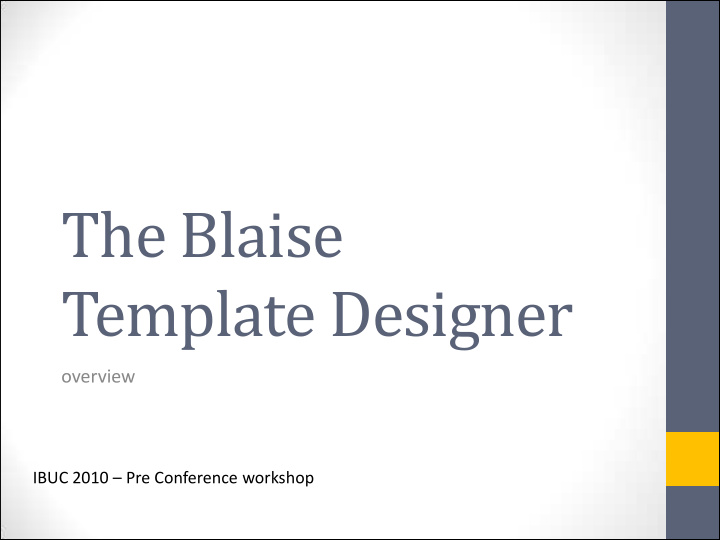



The Blaise Template Designer overview IBUC 2010 – Pre Conference workshop
What is it? • A custom tool to design: • Blaise layout templates: • Master page templates • Field pane templates • Other template types • Grouping, Dialogs, Popups, etc. • Styles • A “domain specific” designer. • Doesn’t replace tools like Adobe Illustrator or Microsoft Expression Blend. Aimed to offer the tools for the vast majority of design needs. • The quickest and easiest way to customize survey layout!
What is a template? • The blueprint for (parts of) the layout of an instrument • Consists of template elements • Shapes • Texts • Input controls • Containers • Placeholders
Template hierarchy Masterpage template X Survey title Question placeholder Field pane template Y Question text placeholder Field pane template Z Question text placeholder A B C Previous Next
Element types • GRID • Is a container element that can hold other elements • Most flexible control for layout • All templates have a grid at the root level • Has columns and rows • Can contain more than 1 element • Can contain sub-grids
Element types • STACKPANEL • Is a container element that stacks other elements • Can contain more than one element Vertically Horizontally Element 1 OR Element 1 Element 2 … Element 2 …
Element types • BORDER • Is a container element that holds another element • Can contain only one element Element x
Element types • PLACEHOLDER • Is a container element that reserves space for elements that are dynamically inserted (at run-time). • You cannot add elements to a placeholder in the designer (at design-time). Content area
What is a placeholder? • An element that reserves space for other elements or template instances. • Example “Content area”: • Has to be placed on a master page template to determine where questions should appear. • Example “Question text placeholder”: • Has to be placed on a field pane template to position the question text.
Styles? • Styles set properties of elements • Colors • Font type, size, weight etc. • Margins • etc. • Changing a style changes all elements that refer to it. • Useful for consistent layout and increased productivity. • A style element is a combination of a key, an attribute and a value. Key Attribute Value • Examples: DefaultBackground BackgroundColor Green InputControlMargin Margin 5
Applying a style Style X Masterpage template X Survey title Question placeholder Field pane template Y Question text placeholder Field pane template Z Question text placeholder A B C Previous Next
Applying a style Style Y Masterpage template X Survey title Question placeholder Field pane template Y Question text placeholder Field pane template Z Question text placeholder A B C Previous Next
Important notices • Layout preferably is dynamic, not fixed • Element sizes are based on • Their content • Environment variables like • Screen resolution • DPI settings in OS • Font sizes • Language settings • Designing templates for dynamic layout makes them more flexible in the (unpredictable) run-time environment.
Important notices • Styles and templates are related • An element refers to a specific style key that the style definition should contain. • Master page templates and field pane templates are related • Esthetics: They probably need to “fit” together. • Consistency • Exception: “ Lookless ” templates (inherit their style from their parent element)
Recommend
More recommend